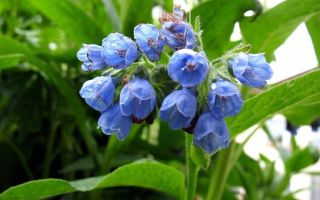Content
The medicinal properties and contraindications to comfrey are of interest from the point of view of traditional medicine. The medicinal plant helps with inflammatory and joint ailments, but it must be used according to all the rules.
Chemical composition of comfrey officinalis
Perennial comfrey, or larkspur, is a plant up to 1 m tall with branched thick roots, narrow leaves and small drooping flowers. The grass grows in humid places on almost any soil, from the middle of summer it bears fruits - dry pods with dark shiny seeds.
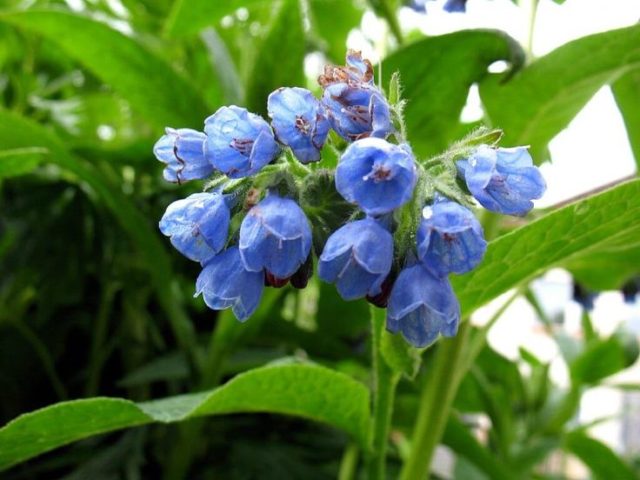
Traditional medicine uses mainly comfrey roots and leaves for treatment. The composition of raw materials contains the following useful substances:
- resins;
- B vitamins;
- glycosides and alkaloids;
- starch and inulin;
- organic acids;
- flavonoids and mucus;
- essential oils.
Allantoin in the composition gives particular value to the perennial. This substance stimulates the accelerated division of cells and promotes the rapid healing of any damage.
Why is comfrey useful?
Traditional medicine uses a perennial herb for both external use and ingestion. Subject to proven recipes, comfrey:
- relieves inflammation of the skin and internal organs;
- has antimicrobial and antiseptic effect;
- helps to stop bleeding;
- promotes expectoration for colds and chronic bronchopulmonary ailments;
- lowers blood pressure with hypertension;
- stimulates peristalsis by increasing muscle tone;
- eases the condition in case of joint diseases;
- relieves inflammation of the skin and promotes the regeneration of the epidermis;
- helps to heal trophic ulcers and purulent wounds;
- has an analgesic effect.
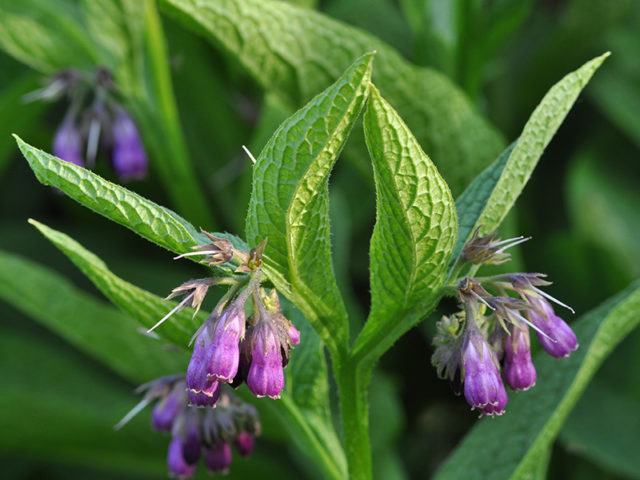
Comfrey is especially useful for joint ailments, it is used for arthritis, rheumatism, gout and osteochondrosis. A perennial plant speeds up the process of bone fusion in case of fractures, eases the condition in case of dislocations and bruises.
Comfrey medicinal harm
The useful comfrey belongs to poisonous plants; it contains the alkaloids consolidin and cinoglossin. You need to use the herb with great care, otherwise it will damage the body:
- An overdose of medicinal comfrey can lead to toxic damage to the liver and minor hemorrhages in its tissues. With prolonged overdose, the plant can cause a carcinogenic effect.
- It is impossible to use medicinal comfrey with existing liver ailments and in the presence of oncological diseases.In these cases, even in small quantities, the plant will do more harm than good.
- In case of an overdose of the plant, nausea, intestinal upset, abdominal pain, dizziness and respiratory distress appear. If you experience such symptoms, you must take a laxative, induce vomiting, and then seek medical help.
In Europe and the USA, the medicinal properties of comfrey root are used exclusively in preparations for external use. In Russia, the medicinal plant is consumed, including inside, but in minimal dosages.

Contraindications to comfrey
The larkspur herb, when used wisely, is not harmful. But there are diseases in which it is strictly prohibited to use it for medicinal purposes. The list of contraindications includes:
- hypotension;
- individual plant intolerance;
- chronic liver disease;
- tumor processes in the body.
It is necessary to abandon the larkspur for pregnant women and mothers during breastfeeding. The medicinal plant should not be offered to children, even with the observance of precautions, it can be used only after 18 years.
Terms of use
The use of a larkspur will be safe if the recipes and dosages are carefully followed:
- Dosages of comfrey broths are on average no more than 100 ml per day. A strong tincture of larkspur is used in only 40 drops per day.
- The total duration of comfrey treatment should not exceed 10 days. Toxic substances in the composition of the plant can accumulate in the body and cause harm to health.
- During the year, the total period of treatment with the larkspur should be no more than 6 weeks.
Recommendations regarding the duration of admission apply, among other things, to the use of the larkspur by external methods.
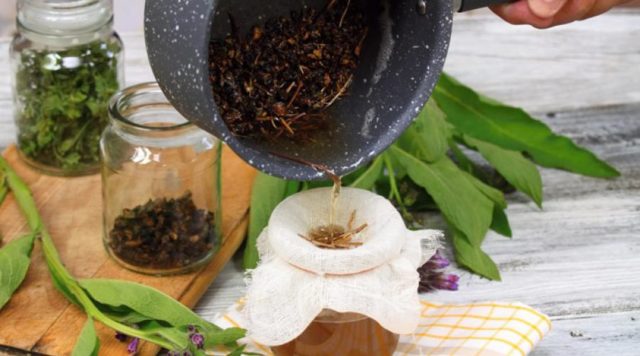
The use of comfrey officinalis
The healing properties of a perennial plant are used by folk and traditional medicine. The areas of application of comfrey overlap, but it can be found more often in home healing recipes.
The use of comfrey in traditional medicine
Folk recipes recommend using larkspur mainly externally. However, there are recipes for the internal use of tinctures and decoctions.
Compress for bleeding
The use of comfrey leaves is indicated for bleeding. They need to be thoroughly washed, cut into small pieces, and then squeezed through cheesecloth.
If blood comes from a cut or abrasion on the skin, then a cotton pad dipped in comfrey juice can be applied to the injury. In case of nosebleeds, a thick tampon is moistened in the juice and placed in the nostril; if necessary, the tampon can be changed 3 times in a row.
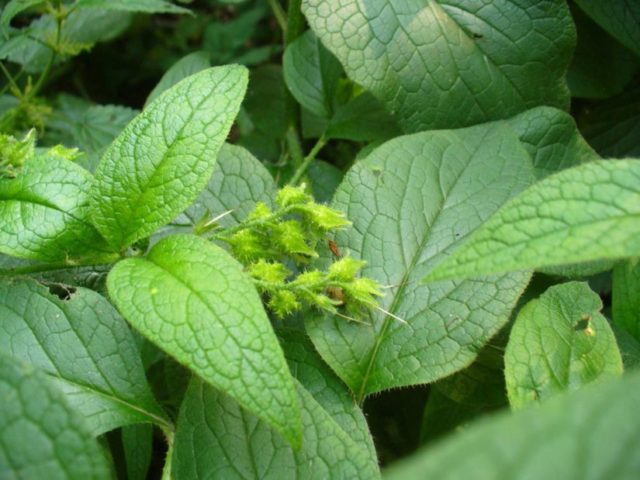
Broth for lotions
For serious bruises, ligament ruptures and fractures, you can make useful lotions from the decoction of the larkspur. To prepare the product you need:
- grind 100 g of dry plant root;
- pour raw materials with a liter of water;
- boil over low heat for 10 minutes;
- strain.
A bandage or a piece of gauze is moistened in a ready-made warm broth and applied to sore spots for half an hour. Herbal decoction helps to relieve discomfort, eliminates tissue swelling and accelerates regeneration.
Infusion on the roots of comfrey for constipation
Comfrey has a mild laxative effect - it can be used to treat constipation. The following infusion is prepared according to the recipe:
- 2 large spoons of powder from the roots pour 500 ml of boiling water in a thermos;
- keep the thermos open for 15 minutes;
- then close the lid and leave to infuse for 7 hours.
The finished infusion is filtered and taken 100 ml on an empty stomach daily. In total, treatment should be continued no more than 10 days.
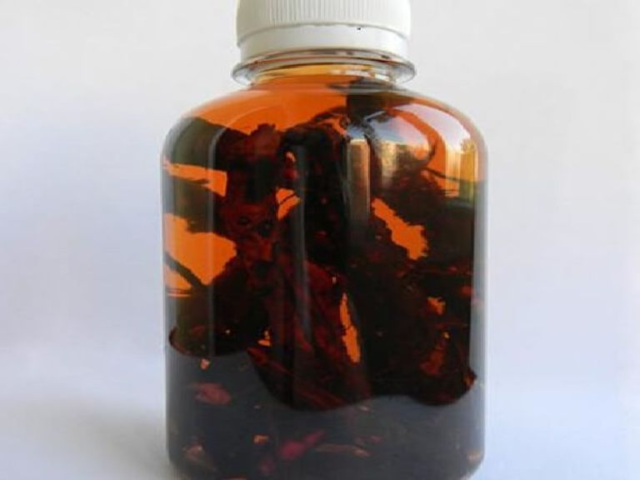
Alcohol tincture for joint treatment
A strong tincture of comfrey brings a good effect on inflammatory ailments of the joints. They do it like this:
- 100 g of powder from the roots of the plant is poured with 500 ml of vodka;
- close the vessel with a lid and remove to infuse for 3 weeks;
- the finished product is filtered.
You can drink the tincture 40 drops on an empty stomach 1 time per day, while the product must be diluted in 100 ml of water.
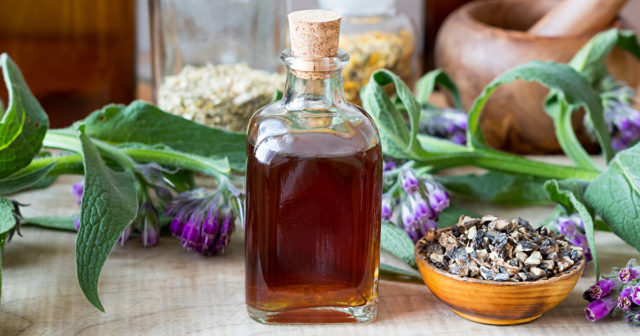
Comfrey root ointment
To use medicinal comfrey for joints at home, you can prepare an ointment from dry roots. They make it according to this recipe:
- 1 large spoonful of crushed larkspur roots are mixed with 2 tablespoons of dried chestnut flowers;
- add a little water so that dry raw materials turn into gruel;
- hold the workpiece in a warm place for half an hour;
- add 4 large tablespoons of pork fat to the mixture and put in the oven for 3 hours.
After processing in the oven, the agent is heated over an open fire for another 5 minutes, and then allowed to cool slightly and squeezed through cheesecloth. A thick ointment is applied with a compress on sore joints or ulcers on the skin, you can keep it all night, having previously fixed it with a bandage.

The use of comfrey in traditional medicine
Official pharmaceuticals recognize the medicinal properties of the larkspur. You can meet the plant as part of ointments, gels and extracts for the external treatment of joints and skin lesions. For example, the following are popular:
- «Comfrey 911»- gel with badyaga extract, comfrey extract, chondroitin and essential oils;
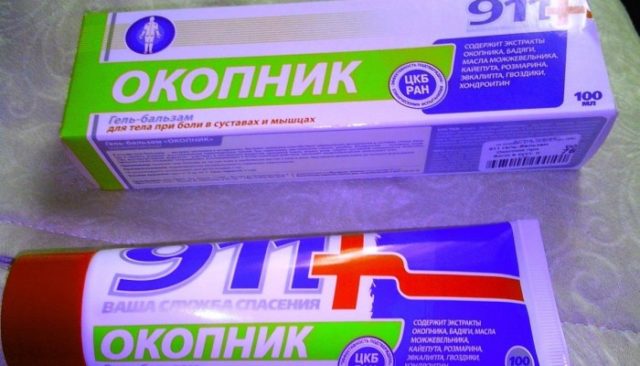 Gel "Comfrey 911" - a certified pharmaceutical product containing larkspur
Gel "Comfrey 911" - a certified pharmaceutical product containing larkspur - «Comfrey Doctor Theiss"- cream with chlorophyll, pine and corn oils, larkspur extract.
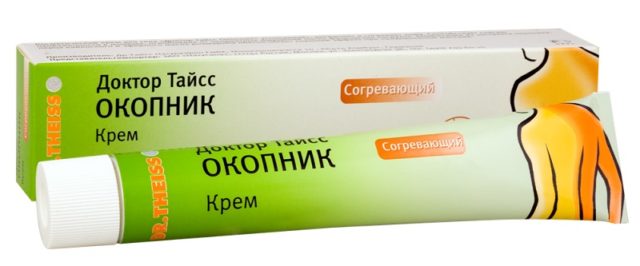 "Comfrey Doctor Theiss" - warming cream for joints
"Comfrey Doctor Theiss" - warming cream for joints
Although larkspur is present in pharmaceuticals in small dosages, the effect is very good.
Comfrey during pregnancy
Useful live bone is not suitable for use during the period of gestation. The active ingredients in the plant help to increase muscle tone, during pregnancy this can lead to miscarriage or early childbirth.
You cannot use the live bone even during breastfeeding. The alkaloids in the medicinal plant will harm the child and cause him severe and dangerous poisoning.
Collection and storage rules
The harvesting of the roots of the medicinal plant is carried out in the fall, from the end of October until the very frost. During this period, the maximum amount of nutrients accumulates in the roots.
For collection, young plant roots are suitable, which are located on the side of the main root. In structure, they should be dense, hard and crunchy, and it is better not to take soft or excessively dry roots. You can break off pieces of rhizome with your hands, but it is better to cut off the raw material with a sharp knife, so less damage will be done to the plant.
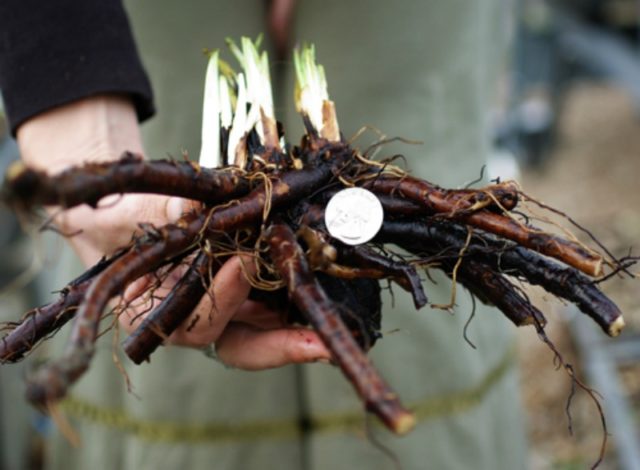
After collection, medicinal raw materials need to be dried. The roots are cleaned from the ground with a brush, then tied with a thick thread and suspended for a week in a dry and well-ventilated room. It will be possible to understand that the raw material has dried qualitatively, it will be possible to cut it, it will turn yellow. In addition, the dry roots of the larkspur break with a resounding crack.
Keep pieces of roots in a paper bag in a dark place with low humidity. The medicinal raw material retains its benefits for 3 years.
Conclusion
The medicinal properties and contraindications to comfrey deserve a detailed study. A medicinal plant helps well with inflammation and diseases of the joints, but it must be used with caution. Since the larkspur is toxic, it is important to observe the correct dosages of infusions, tinctures and ointments.
Reviews on the use of comfrey root in traditional medicine

